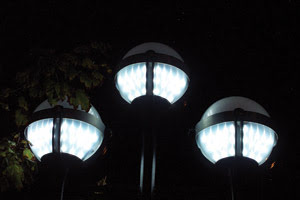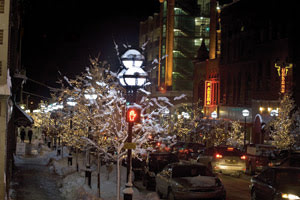Driving down the highway, zinging by countless streetlights, we rarely consider the technology behind them, their cost or how much energy they consume. Not much has changed in streetlights in decades.
But change is afoot, as lighting designers test more energy-efficient, lower-maintenance and longer-lasting lighting sources. It’s enough to make you slow down and take notice.
In 2005, the Lighting Research Center (LRC) at Rensselaer Polytechnic Institute (RPI) in Troy, N.Y., surveyed utilities and cities and found that high-pressure sodium lamps were used in 83 percent of streetlights, mercury vapor in 11 percent, metal halide in 5 percent, and a mixture of fluorescent, low-pressure sodium, incandescent or LED sources in the remaining 1 percent. In 2000, it was estimated that street lighting consumed 14 billion kWh per year in the US.
An obvious choice?
To save energy, the obvious choice would seem to be LEDs as the light source. Test projects are under way in cities such as Ann Arbor, Mich., Austin, Texas, and Raleigh, N.C. Ann Arbor completed a pilot program two years ago that resulted in 600 of its 1046 downtown streetlights being replaced with LED fixtures. In Austin, several manufacturers’ LED products are being tested in about 12 streetlights, and in a pilot project in Raleigh, LED-based streetlights have been installed around the convention center.

LEDs light up the night in a pilot project in Ann Arbor, Mich. Photo courtesy of the city of Ann Arbor.
Results highlight LEDs’ advantages, including lifetimes of 50,000 h – depending on considerations such as the design of the heat sink – according to John Bullough, an adjunct assistant professor at RPI and a scientist at LRC.
LED-based streetlights manufactured by BetaLED of Sturtevant, Wis., are under test in cities such as Racine, Wis., Austin and Raleigh. The heat sinks mounted to each light bar – which each contain 20 LEDs – help keep the LEDs at an optimal temperature.

In a pilot study in Ann Arbor, Mich., LED streetlights were found to work well in a cold, wintry climate. Photo courtesy of Dwight Cendrowski.
Compared with the 24,000 h estimated for high-pressure sodium, a switch to LEDs means less maintenance because bulbs do not need to be replaced as often. LEDs also contain no mercury (as compared with fluorescents), so at the end of their life (which can be a decade or more), hazardous waste is not an issue.
An incentive to installing LED lighting is its overall cost. If the light source for streetlights were chosen on a first-cost basis alone, high-pressure sodium would win hands down. They have been manufactured for a long time, are widely available, and their pricing is consistent. They also are fairly efficient in terms of lumens per watt and in their lifetimes.
The upfront cost of LED fixtures is higher, but lower energy and maintenance costs are well worth the initial investment, according to Michael Bergren, assistant field operations manager for the city of Ann Arbor. The city expects the payback period to be only 4.2 years. And in terms of life expectancy, LEDs can’t be beat. If a streetlight is on 12 hours a day, or 4380 hours a year, the LED light source should last 11 to 12 years, Bullough estimates.
That could make changing lightbulbs almost a distant memory.
Solar-Powered LEDs
Running LED-based streetlights with solar panels will become more common when solar efficiencies are high enough to make a small panel viable on each light. The pairing makes perfect sense from an electrical standpoint because solar energy is provided in the form of direct current, on which LEDs run.
This means that an LED-based streetlight draws electricity straight from the panel without having to be transformed into alternating current, as would be the case with light sources such as high-pressure sodium.
One pilot project being conducted by BetaLED in Sullivan County, N.Y., soon will show just how effective the sun can be in lighting our streets.
Night Vision
Another issue under study is how sensitive the human eye is to various parts of the light spectrum. Measurement of light is based on the response of the cones in our eyes, according to John Bullough from the Lighting Research Center (LRC). But under low-light levels, for example, the rods and cones in the eye are used to see. So at night, a light source that – on paper – has more lumens, such as high-pressure sodium, is not as visually effective as you might think.
Studies conducted by LRC and summarized in a technical memorandum from the Illuminating Engineering Society have shown that reds and yellows are not seen as well in low light as are the blue and green parts of the spectrum. White LEDs contain wavelengths in the blue light range and, because this is more visible to the human eye at low light levels, LED streetlights can provide nighttime visibility similar to the more yellow lights.
Scott Jarman, a consulting engineer with Austin Energy, a municipally owned utility in Texas, acknowledged that new standards are needed. The color rendering index (CRI) of LEDs is excellent, he noted, but “if you go out with a light meter, these LED streetlights are going to be low, even if the visibility is high as a result of the CRI.”
LRC is working on developing a unified photometry system that lighting designers could use to tune lighting so that it is more readily visible to the human eye.